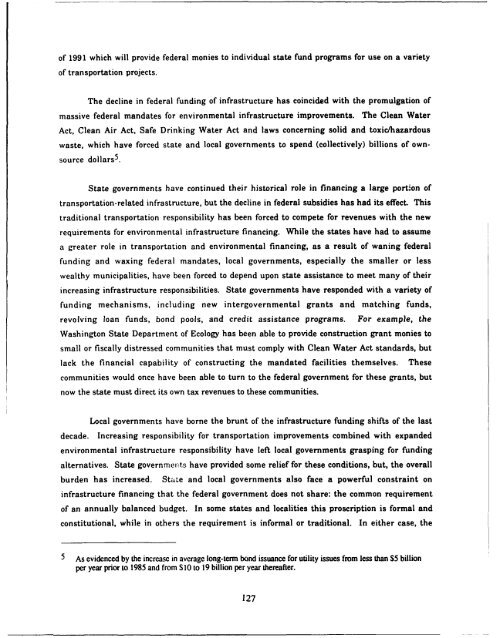Challenges and Opportunities for Innovation in the Public Works ...
Challenges and Opportunities for Innovation in the Public Works ...
Challenges and Opportunities for Innovation in the Public Works ...
You also want an ePaper? Increase the reach of your titles
YUMPU automatically turns print PDFs into web optimized ePapers that Google loves.
of 1991 which will provide federal monies to <strong>in</strong>dividual state fund programs <strong>for</strong> use on a variety<br />
of transportation projects.<br />
The decl<strong>in</strong>e <strong>in</strong> federal fund<strong>in</strong>g of <strong>in</strong>frastructure has co<strong>in</strong>cided with <strong>the</strong> promulgation of<br />
massive federal m<strong>and</strong>ates <strong>for</strong> environmental <strong>in</strong>frastructure improvements. The Clean Water<br />
Act, Clean Air Act, Safe Dr<strong>in</strong>k<strong>in</strong>g Water Act <strong>and</strong> laws concern<strong>in</strong>g solid <strong>and</strong> toxic/hazardous<br />
waste, which have <strong>for</strong>ced state <strong>and</strong> local governments to spend (collectively) billions of own-<br />
source dollars 5 .<br />
State governments have cont<strong>in</strong>ued <strong>the</strong>ir historical role <strong>in</strong> f<strong>in</strong>anc<strong>in</strong>g a large portion of<br />
transportation-related <strong>in</strong>frastructure, but <strong>the</strong> decl<strong>in</strong>e <strong>in</strong> federal subsidies has had its effect. This<br />
traditional transportation responsibility has been <strong>for</strong>ced to compete <strong>for</strong> revenues with <strong>the</strong> new<br />
requirements <strong>for</strong> environmental <strong>in</strong>frastructure f<strong>in</strong>anc<strong>in</strong>g. While <strong>the</strong> states have had to assume<br />
a greater role <strong>in</strong> transportation <strong>and</strong> environmental f<strong>in</strong>anc<strong>in</strong>g, as a result of wan<strong>in</strong>g federal<br />
fund<strong>in</strong>g <strong>and</strong> wax<strong>in</strong>g federal m<strong>and</strong>ates, local governments, especially <strong>the</strong> smaller or less<br />
wealthy municipalities, have been <strong>for</strong>ced to depend upon state assistance to meet many of <strong>the</strong>ir<br />
<strong>in</strong>creas<strong>in</strong>g <strong>in</strong>frastructure responsibilities. State governments have responded with a variety of<br />
fund<strong>in</strong>g mechanisms, <strong>in</strong>clud<strong>in</strong>g new <strong>in</strong>tergovernmental grants <strong>and</strong> match<strong>in</strong>g funds,<br />
revolv<strong>in</strong>g loan funds, bond pools, <strong>and</strong> credit assistance programs. For example, <strong>the</strong><br />
Wash<strong>in</strong>gton State Department of Ecology has been able to provide construction grant monies to<br />
small or fiscally distressed communities that must comply with Clean Water Act st<strong>and</strong>ards, but<br />
lack <strong>the</strong> f<strong>in</strong>ancial capability of construct<strong>in</strong>g <strong>the</strong> m<strong>and</strong>ated facilities <strong>the</strong>mselves. These<br />
communities would once have been able to turn to <strong>the</strong> federal government <strong>for</strong> <strong>the</strong>se grants, but<br />
now <strong>the</strong> state must direct its own tax revenues to <strong>the</strong>se communities.<br />
Local governments have borne <strong>the</strong> brunt of <strong>the</strong> <strong>in</strong>frastructure fund<strong>in</strong>g shifts of <strong>the</strong> last<br />
decade. Increas<strong>in</strong>g responsibility <strong>for</strong> transportation improvements comb<strong>in</strong>ed with exp<strong>and</strong>ed<br />
environmental <strong>in</strong>frastructure responsibility have left local governments grasp<strong>in</strong>g <strong>for</strong> fund<strong>in</strong>g<br />
alternatives. State governmer~ts have provided some relief <strong>for</strong> <strong>the</strong>se conditions, but, <strong>the</strong> overall<br />
burden has <strong>in</strong>creased. State <strong>and</strong> local governments also face a powerful constra<strong>in</strong>t on<br />
<strong>in</strong>frastructure f<strong>in</strong>anc<strong>in</strong>g that <strong>the</strong> federal government does not share: <strong>the</strong> common requirement<br />
of an annually balanced budget. In some states <strong>and</strong> localities this proscription is <strong>for</strong>mal <strong>and</strong><br />
constitutional, while <strong>in</strong> o<strong>the</strong>rs <strong>the</strong> requirement is <strong>in</strong><strong>for</strong>mal or traditional. In ei<strong>the</strong>r case, <strong>the</strong><br />
5 As evidenced by <strong>the</strong> <strong>in</strong>creasc <strong>in</strong> average long-term bond issuance <strong>for</strong> utility issues from less than $5 billion<br />
per year prior to 1985 <strong>and</strong> from S10 to 19 billion per year <strong>the</strong>reafter.<br />
127







